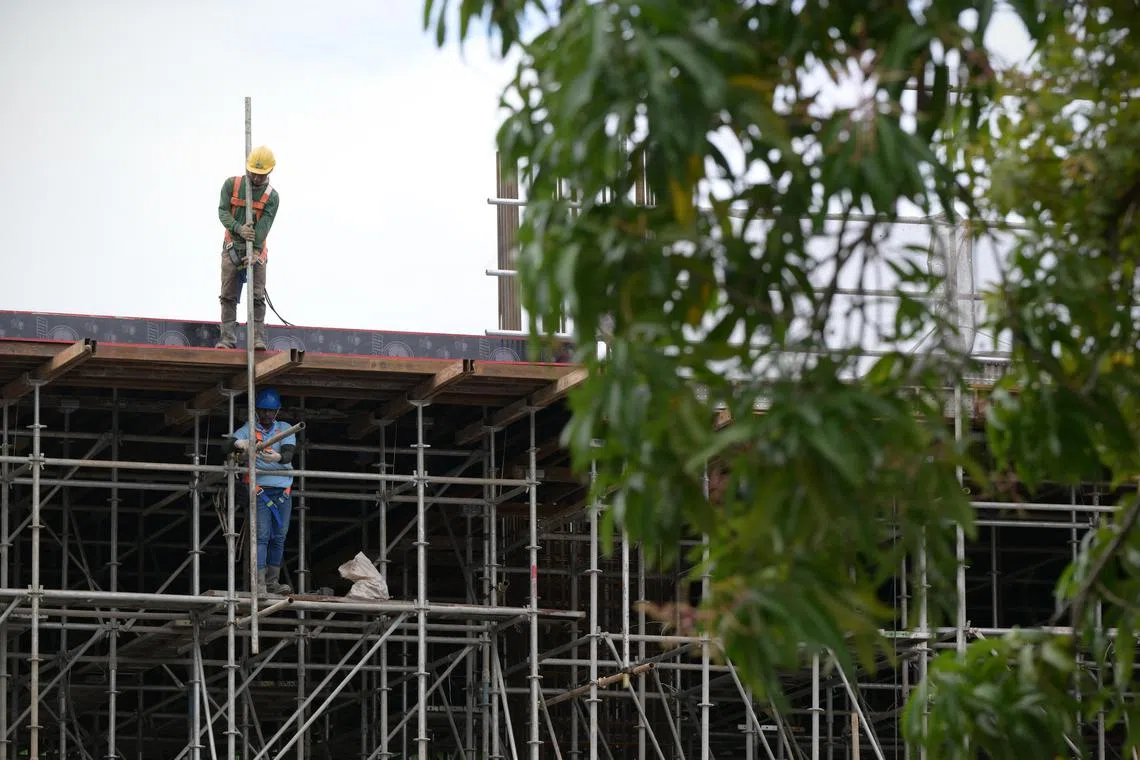9 construction sites where workers died in second half of 2024 had inadequate safety measures
Sign up now: Get ST's newsletters delivered to your inbox

The discussion in Parliament came after MOM reported a tripling of construction worker deaths, from five in the first half of 2024 to 15 in the second half.
ST PHOTO: NG SOR LUAN
Follow topic:
SINGAPORE – Of the 14 construction sites where workers died in the second half of 2024, nine were found to have had inadequate safety management systems, posing an imminent danger to those working there.
As a result, these sites were ordered to stop work, and were allowed to resume only after undertaking remedial measures, such as reviewing their safety systems, said Senior Minister of State for Manpower Zaqy Mohamad.
Giving these details in Parliament on Jan 7 in response to questions from five MPs about what was described as a worrying rise in fatal accidents here, Mr Zaqy called for the construction sector to step up on safety.
He also urged greater vigilance as the Chinese New Year period approaches and firms face time pressure to complete their projects.
At the same time, he asked for time to be given to the industry to respond to the suite of measures that the Ministry of Manpower (MOM) rolled out in 2024 to reduce the number of worker deaths and injuries here.
These measures include requiring video surveillance systems to be installed placing more weight on safety considerations
“I assure members that we are doing all we can,” Mr Zaqy said.
“On our part, we will monitor the progress of the measures implemented to further improve safety and accountability.”
Since 2017, Singapore’s goal has been to reduce its annual workplace fatality rate to less than one death per 100,000 workers on a sustained basis before 2028.
Mr Zaqy pointed out that Singapore’s average workplace fatality rate has been falling, averaging 1.1 deaths per 100,000 workers.
He noted that this figure is better than in many developed countries, but not yet on a par with top performers, such as the Netherlands.
“Construction fatalities remain over-represented in Singapore, with almost half of our (workplace) fatalities coming from the construction sector.
“So the companies and the workers in the sector can certainly do better,” he said.
The discussion in Parliament on Jan 7 came after MOM reported in December 2024 a tripling of construction worker deaths,
The spate of deaths had continued even after firms were strongly encouraged in November 2024 to impose a safety timeout.
This is where companies temporarily suspend operations to review procedures and complete a list of activities, such as refreshing workers’ awareness of best practices.
Mr Sharael Taha (Pasir Ris-Punggol GRC) asked about the effectiveness of safety timeouts, which MOM has called for several times in the past when workplace deaths had spiked.
To this, Mr Zaqy said that safety timeouts on their own are not a panacea, and they are meant to complement MOM’s overall enforcement efforts.
He cited the more than 3,000 inspections that were conducted in 2024, targeting key concerns such as working at height and vehicular safety. He said MOM will continue with enhanced enforcement efforts ahead of the Chinese New Year period.
Asked by labour MP Melvin Yong (Radin Mas) about the profile of companies that were responsible for the recent increase in worker deaths, and whether they involved large, medium-sized or small construction projects, Mr Zaqy said he did not have the information offhand.
But he flagged smaller firms involved in renovation work, maintenance and facilities management as an area of concern.
Workers’ Party MP He Ting Ru (Sengkang GRC) asked if MOM would automatically require external safety audits and specific structural changes to be implemented before work can resume at worksites with fatalities.
In response, Mr Zaqy said there is still a requirement for companies to conduct external safety audits after serious safety lapses.
He noted that none of the 14 construction sites where there were fatal accidents in the second half of 2024 had previously been issued with stop-work orders.
Such orders last a minimum of three weeks and can apply to the entire worksite, or specific parts of the workplace.
According to the latest records on MOM’s website, stop-work orders remain in force for at least two companies that have had a worker die on their worksite in the second half of 2024.
They are Jin Shan Construction


